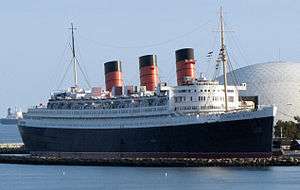Poseidon (fictional ship)
| SS Poseidon | |
|---|---|
| The Poseidon Adventure | |
 In the 1972 film the SS Poseidon is based on the RMS Queen Mary. | |
| Type | steamship |
The S.S. Poseidon is a fictional trans-Atlantic liner that first appeared in the 1969 novel The Poseidon Adventure by Paul Gallico and later in four films based on the novel. The ship is named after the god of the seas in Greek mythology.
Descriptions
The original novel ( Book )
In the 1969 novel, the steamdriven ship is traveling across the Atlantic on a month-long tour of African and South American ports, after its conversion from an ocean liner into a cruise ship.[1] On December 26, the ship capsizes when a landslide on the Mid-Atlantic Ridge produces a huge tsunami. The description of the ship is slim, but in his novel, Gallico described it as a quadruple-screw ocean liner of 81,000 tons, as long as four city blocks, and as high as an apartment building. He also wrote that it had three "massive" funnels. But he also described it as having a fatal flaw: it "was riding high in the water, improperly ballasted and technically unseaworthy." This, he wrote, made it vulnerable to capsizing by tsunamis.
The 1972 film version
In the 1972 film, The Poseidon Adventure, the ship is in the Mediterranean on her final voyage, which will take her to the breaker's yards in Greece, when an undersea earthquake produces a rogue wave that capsizes the ship just after midnight on New Year's Eve. The film uses the RMS Queen Mary as a stand-in for Poseidon, using actual onboard locations as well as model shots. The captain (Leslie Nielsen) complains about Poseidon being top-heavy and hence vulnerable to capsizing by tsunamis, and he makes clear his intent to take on ballast, but the representative of the owners refuses to allow this and indeed, orders him to proceed at full speed, threatening to fire him and replace him with another officer. Of the hundreds aboard, no more than a handful survive.
Beyond the Poseidon Adventure
In the 1979 film, Beyond the Poseidon Adventure, which is a direct continuation of the story from the first film, the Poseidon is an abandoned overturned wreck that has not yet sunk. She is boarded by a small group of salvagers and a group of terrorists in disguise (who are looking for gold and a lost plutonium shipment). Eventually trapped in the ship, they encounter a group of passengers and crew who are still aboard. In the end, the Poseidon's boilers and plutonium cargo explode, sinking the ship permanently and, worse, irradiating her wreckage to unsafe levels.
The 2005 TV film
In the 2005 TV film, The Poseidon Adventure, Poseidon is a modern motor driven cruise ship using propeller pods, which is sailing from Cape Town, South Africa on a cruise through the Indian Ocean to Sydney, Australia. The events that lead to the capsize of the ship vary greatly from the original book, as it is a partly foiled terrorist plot to sink the ship using explosives below the water line which leads to Poseidon rolling over.
Poseidon
In the 2006 film, Poseidon, the ship is not a cruise ship, but a British ocean liner registered in Southampton, which is sailing from an unnamed port in the United Kingdom (presumably London as one of the characters mentions it briefly) to New York City. While the first film used Queen Mary as a stand-in for Poseidon, the ship in the 2006 film has an original exterior design not based on any real-life vessel although the interior was inspired by the ocean liner RMS Queen Mary 2. This Poseidon is also struck by a huge rogue wave just after midnight on New Year's Eve and capsizes, but unlike the original the cause of the wave is never explained.

Commonality
In the bulk of each story, a group of survivors try to make their way to the overturned top of the capsized liner, hoping to get to safety.
References
- ↑ Gallico, Paul - The Poseidon Adventure